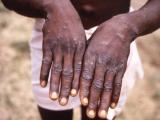Sep 17, 2002 (CIDRAP News) – The current high prevalence of eczema, or atopic dermatitis (AD), suggests that a large share of the population could be at risk for the serious side effect of eczema vaccinatum (EV) if they underwent smallpox vaccination, according to specialists writing in the September Journal of Allergy and Clinical Immunology.
The lifetime prevalence of AD is now estimated at 10% to 15%, and probably twice that number of people have a close contact who has AD, write Renata J. M. Engler, MD, of Walter Reed Army Medical Center in Washington, DC, and two colleagues. Since vaccinia virus can spread from vaccine recipients to others, these figures imply that up to half the population might be ineligible for smallpox vaccination in the absence of exposure to smallpox, the authors state.
Further, they write, clinical or immunologic markers of the risk of EV in those with a history of AD are lacking. "The lack of reliable clinical and historical indicators to predictably identify individuals at risk for EV greatly hampers our ability to safely and economically protect our population from smallpox," they state.
EV—the spread of vaccinia virus infection over large areas of skin in people with active or inactive eczema—was fatal in about 1% to 6% of cases in the era of smallpox vaccination, the report says. In a smallpox vaccination campaign in Wales in 1962, EV occurred in 123 people per million vaccinated, and it was fatal in about 1% of cases.
The prevalence of AD during the smallpox vaccination era is not precisely known, but many studies suggest that the rate has increased substantially since then, the authors assert. For example, a 1998 study reported a rate of 21% in Japanese schoolchildren 5 to 9 years old. "It may conservatively be estimated that the rates of AD have doubled and possibly tripled since the era of routine smallpox vaccination," Engler and colleagues write.
"Given that the lifetime prevalence of AD is ~10% to15%," they continue, "that perhaps this many people (or even more) have a 'history of eczema' (which includes patients with AD), and that likely twice this many people have a contact who has active or quiescent AD, it is conceivable that up to half of the population [italics in original] currently would not be eligible to routinely receive smallpox vaccination."
This circumstance would frustrate efforts to increase herd immunity in the population, the article says. And if a deliberate release of smallpox triggered mass vaccinations, there would be a "staggering number of vaccinees potentially at risk for developing EV."
However, two factors could lower the number of people considered ineligible for smallpox vaccination, the article says. First, because AD is a genetic disease, the observations of increased prevalence might reflect familial clustering of the disease rather than a general increase throughout the population. "Second, contacts of patients with AD might be able to receive smallpox vaccination if special precautions were to be taken—eg, isolation or extreme care with the vaccination site."
The authors also review evidence of immune-system abnormalities that may contribute to EV in people who have AD. They cite several changes or defects in both adaptive immunity (eg, decreased cytotoxic T-cell generation, reduced interferon-gamma and interleukin-18 responses) and innate immunity (eg, lack of neutrophils in skin inflammation, reduced natural-killer-cell function) that may play a role.
The article calls for research to answer nine questions about AD and EV, pertaining to such things as laboratory markers for risk of EV, the best screening questions to identify people at risk, and methods for preventing the secondary spread of vaccinia to contacts of vaccine recipients.
A nonreplicating (attenuated) vaccinia vaccine may be a solution for people who have AD, and clinical trials of such a vaccine are being planned, the authors say. However, it will be important to determine if a nonreplicating vaccine will generate an adequate immune response, the article concludes.
Engler RJM, Kenner J, Leung DYM. Smallpox vaccination: risk considerations for patients with atopic dermatitis. J Allerg Clin Immunol 2002;110(3):357-65



















